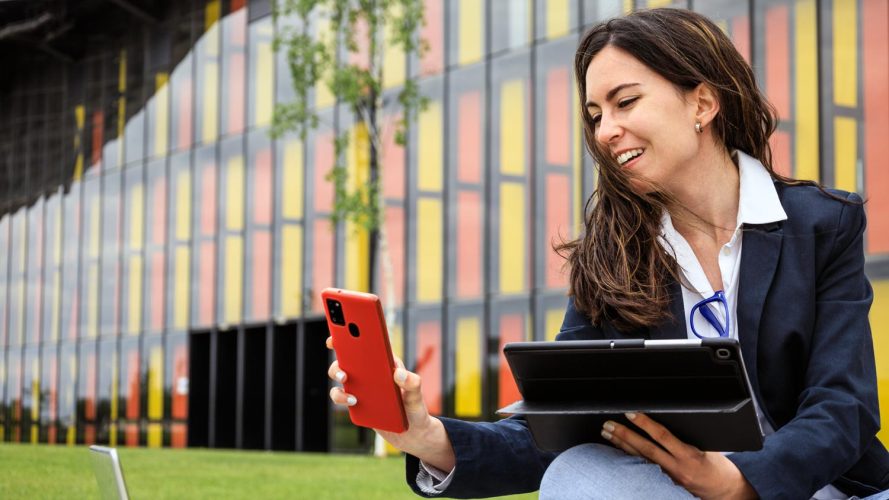How To Make Your Mobile App Experience Stand Out in the “Attention Economy”



Billions of mobile apps are downloaded each year. One-quarter of them are accessed only once. How do you stand out from the pack and keep mobile users engaged?
We’ve all heard the phrase ‘time is money’ but in the world we live in, it’s not time that converts to dollars, it’s attention. Consumers are overloaded with screens, content and information, making their attention a scarce commodity. How can brands get and hold their attention, particularly on mobile, with a mobile app experience that stands out?
First, consider some statistics: 218 billion mobile apps were downloaded in 2020, up from 140.7 billion in 2016; Nearly 55% of internet traffic is now coming from mobile devices; In the first quarter of 2021, mobile orders grew by 62%; 46% of Americans say they check their phones before they even get out of bed in the morning. Mobile is ingrained in every aspect of our lives and has become one of the primary ways for businesses to engage with customers.
But when consumers are drowning in a sea of information, how can businesses make their mobile app experiences stand out? Before we answer that, let’s take a deeper look at what the attention economy is, and how understanding the concept can help you make informed decisions when you design your mobile app experience.
What is the attention economy?
American economist and psychologist Herbert A. Simon developed the concept of the attention economy as early as 1971. In his article, Designing Organizations for an Information-Rich World, he wrote,
“In an information-rich world, the wealth of information means a dearth of something else: a scarcity of whatever it is that information consumes. What information consumes is rather obvious: it consumes the attention of its recipients. Hence a wealth of information creates a poverty of attention…”
While the information accessed daily may seem to be free, it’s not. People are “paying” with their attention. Attention is power. Once you have someone’s attention, you have the power to influence them.
You might wonder what this concept has to do with your mobile app experience. The answer is — everything. We live on our phones. That’s why it’s so important that your mobile app experience stands out to capture and keep your audience’s attention. Here are three ways to make your mobile app experience shine.
Make the user experience consistent across all digital channels
According to the Salesforce State of the Connected Consumer Report, customers use an average of nine digital channels to browse inventory, seek advice, and make purchases, and 66% of customers report using multiple devices on their way to completing a transaction. Today’s customers not only use mobile apps to access information no matter where they are, they also want their mobile app experience to be consistent with their mobile web and desktop experiences. For example, when a user logs into their mobile app to make a purchase and adds items to their cart, those same items should show up in their cart when they log in using their mobile web browser or sign in to their desktop site.
However, creating that consistent user experience across all digital channels can be a steep challenge. Forrester’s 2021 Total Economic Impact (TEI) of Experience Cloud said it could potentially take a company six months at a cost of $30,000 each month to develop a mobile application. This can be an acute challenge especially for companies that don’t have a team of in-house developers or the budget for a third-party partner.
Fortunately, brands can invest in technology like Mobile Publisher for Experience Cloud, one of Salesforce’s innovative and powerful low-code tools that empowers any creator to build, brand, and distribute engaging mobile apps, fast. According to the TEI report, businesses that used Salesforce Mobile Publisher accelerated their mobile app delivery with development cost savings of up to $191,000. With one tool, brands easily keep their web experience and mobile app experience in sync without the need for two different development teams. With just a few clicks, marketers can turn a desktop experience into a branded mobile app, and publish it directly to the Google Play and Apple iOS app stores.
Personalize it by connecting it to data
In the first quarter of 2021, there were about 5.7 million apps in the Google Play and Apple App stores combined. With so many apps for mobile users to choose from, it’s safe to say the app space is highly competitive.
How can you ensure your app is one of the millions chosen from the bunch? Customizing the look and feel of your app with branded app images and content may attract users to download it, but personalization is what keeps them coming back.
According to McKinsey, personalization leaders have driven 5%-15% increases in revenue and 10%-30% increases in marketing-spend efficiency with personalization. Surprisingly, however, only 32% of marketers incorporated personalization into their mobile app experience strategies, compared to email where 78% of marketers incorporated personalization. Marketers are missing a huge opportunity to provide the personalized experiences consumers demand. In a world where 66% of customers say brands treat them like a number, providing a 1:1 personalized experience is a key differentiator. More importantly, it’s what consumers expect, with 52% of customers expecting offers to always be personalized, a 49% increase from 2019.
To personalize your app experiences, you have to track customer data. Tracking customer data helps you know your customers and provide them with what matters most to them. Collecting data can be as simple as surveying customers about their preferences. Or, you can collect behavioral data such as purchase history, location, or page visits. This allows you to offer customers, for example, their favorite coffee (without having to place the order from scratch), or a discount on the pants that match the top they just purchased. Customers don’t want a one-size-fits-all experience. They want a tailored experience that’s unique to them, and data is the key. In fact, According to the Digital Trends report, 78% of marketers say their customer engagement is data-driven.
Make it engaging by playing to mobile’s strengths
Now that you’ve captured your customer’s attention and have influenced them to download your app, the challenge is keeping them coming back. Did you know that 25% of apps downloaded worldwide are only accessed once after download? Creating an engaging experience will increase app usage, customer retention, and help your app stay out of the 25% of one-time visits. Putting out an app isn’t enough, you’ve got to keep innovating on mobile and keep pushing that experience to make the most of the user’s time — and device.
There are many features you can use to create an engaging experience. Push notifications are a popular feature. They are pop-up messages that allow a user to engage with your app even if they are not actively using it at the time of the notification. To enable these notifications, a user must subscribe to them and give permission to receive them. Some examples: subscription notifiers which encourage customers to sign up, price-drop notifiers, out-of-stock notifiers, and geo-location notifiers.
Geolocation is another feature that helps guide your tailored app content, as you can create content that is linked to a specific city or even climate. For example, if you have a customer in New York City, and it’s raining, you can recommend the rain boots on sale, versus a customer in southern Florida, who may see recommendations for discounted bathing suits and beach attire.
You’ll also want to tailor your overall app content in real-time based on data such as user behavior and location. Conducting A/B testing is one of the best ways to make informed decisions about the content on your site. For example, if a company sends different offers to VIP members versus first-time visitors, you can tailor the homepage accordingly. VIP members may receive tailored offers based on their preferences and purchase history, while first-time visitors may encounter a new customer welcome promotion, or more information about the different services offered, ultimately differentiating the experience between the two types of users.
These features allow you to use data, coupled with personalization, to send the right message at the right time, which ultimately makes your app more useful. Usefulness encourages the user to engage, and return for more. Once users engage with your app, you can track clicks and conversions to determine how well your notification strategy is working.
Mobile apps can also help streamline internal processes, making work more efficient for employees and partners, while also delivering fast, quality service to customers. One way of doing this is through the camera. With the camera, companies improve operational productivity by scanning barcodes and tracking inventory. This helps minimize and reduce human error. Most recently, companies are relying on QR codes to improve both the employee and customer experiences. For example, scanning a QR code on the door of the doctor’s office allows customers to check in, while front-desk employees focus on other needs, such as taking calls. Or, scanning QR codes at restaurants allow customers to view the menu and pay without having to wait for a server.
A frequently-cited study found that the average human attention span is just eight seconds, shorter than that of a goldfish. What will you do the next time you’re lucky enough to catch your customer’s valuable eight seconds of attention with your app? It used to be that duplicating the desktop experience into a mobile app format was enough for brands to claim they had a mobile experience. But creating an app for the sake of having one is not nearly enough. Remember, above almost all else that mobile apps need to be useful. Understanding who your user is and how you can meet their needs through a mobile app experience will help you add value to your customer’s lives, and make the most of their time.
Build a better mobile app experience
You can create a mobile app that gives you a 360-degree view of your customer, and provides your customers with a consistent experience across desktop and mobile.



























